- November 22, 2024
-
-
Loading

Loading

Those temporary speed humps on St. Armands Circle could be sticking around for a while.
At Wednesday’s St. Armands Business Improvement District meeting, city engineer Alex DavisShaw said the Florida Department of Transportation could leave the traffic-calming devices in place for three to five years if state officials determined they were improving the quality of the roads within the commercial district.
FDOT installed eight temporary speed humps near intersections around the Circle earlier this summer. The agency is using the project as an opportunity to evaluate the efficacy of the humps, which are designed to slow traffic and improve pedestrian safety.
The concept of installing speed humps drew support from city officials and some St. Armands leaders, who expressed concern about vehicles speeding in the area — particularly as they exited the Circle to go to Longboat Key or mainland Sarasota. But at Wednesday’s St. Armands BID meeting, those in attendance said they had heard some mixed reactions to the traffic features.
BID board member Geoffrey Michel said he felt the speed humps improved the pedestrian experience on the Circle. But board member Gavin Meshad expressed some concerns that the humps were causing the flow of traffic to become less efficient and questioned whether all eight of the devices were necessary.
“It’s working,” Meshad said. “It’s slowing them down, but it’s slowing them down too much.”
If the speed humps prove effective, state and city officials are pursuing a project that would elevate crosswalks around the Circle as a more permanent traffic-calming measure. DavisShaw said she was hopeful the Sarasota-Manatee Metropolitan Planning Organization would approve funding for that project in its next budget cycle, but she said the process could take years.
As a result, she said the black-and-yellow temporary speed humps could become a longer-term fixture.
“If some are working, they’d probably keep them in,” DavisShaw said.
FDOT spokesman Brian Rick said the agency would use crash data to determine if the speed humps had any effect, though he acknowledged that might be an ineffective performance measure because there is not a high incidence of pedestrian-involved crashes in the area. Rick said FDOT advised the city and BID to survey stakeholders to evaluate how the speed humps are affecting driver and pedestrian behavior.
In their discussion with DavisShaw, BID members also expressed a desire for the city to consider installing higher-quality signposts and improved sidewalks. The board said it hoped to better coordinate any projects in the Circle with city staff.
The BID said it would try to meet with FDOT to continue its conversation about the speed humps. Although Meshad had questions about effects the devices were having on traffic now, he speculated the issue might go away in season when more cars are present.
“A part of me is saying, once it’s crowded, it’s crowded, whether you have speed tables or not,” Meshad said.